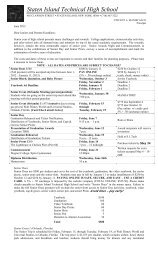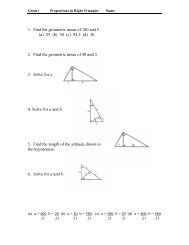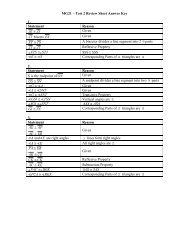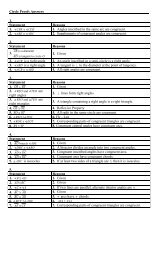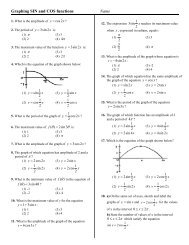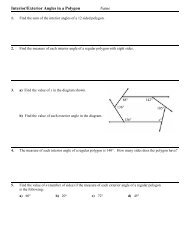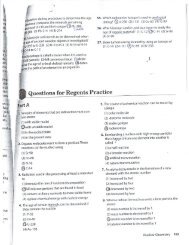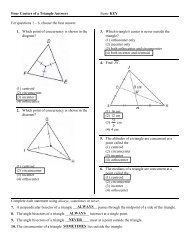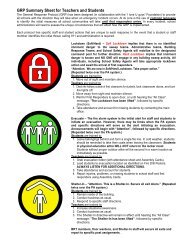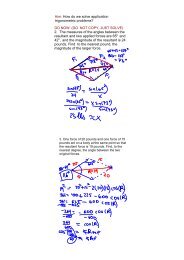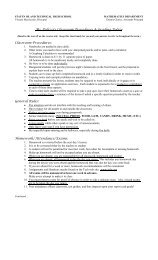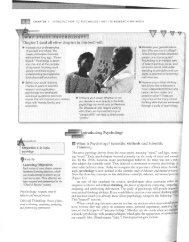Aim: How do we find the equation for a compound locus? Do Now ...
Aim: How do we find the equation for a compound locus? Do Now ...
Aim: How do we find the equation for a compound locus? Do Now ...
Create successful ePaper yourself
Turn your PDF publications into a flip-book with our unique Google optimized e-Paper software.
<strong>Aim</strong>: <strong>How</strong> <strong>do</strong> <strong>we</strong> <strong>find</strong> <strong>the</strong> <strong>equation</strong> <strong>for</strong> a<strong>compound</strong> <strong>locus</strong>?<strong>Do</strong> <strong>Now</strong>: Write <strong>the</strong> <strong>equation</strong> of <strong>the</strong> <strong>locus</strong> thatsatisfies <strong>the</strong> given conditions:(A) abscissas are 5(B) ordinates are 4(C) ordinate is 3 less than twice <strong>the</strong> abscissa(D) abscissa and <strong>the</strong> ordinate have a sum of 3(E) 3 units away from y = 2(F) 5 units away from x = 0The <strong>locus</strong> "n" units away from <strong>the</strong> linex = b is made up of two lines whose<strong>equation</strong>s arex = b + n , x = b n
Locus equidistant from two fixed pointsWrite <strong>the</strong> <strong>equation</strong> of <strong>the</strong><strong>locus</strong> equidistant from(a) (4,2) , (6,2)(b) (5, 4) , (5, 10)(c) (0,1), (4,3)876543218 7 6 5 4 3 2 110 1 2 3 4 5 6 7 82345678yxTo <strong>find</strong> <strong>the</strong> <strong>equation</strong> of <strong>the</strong> perpendicular bisector(1) graph <strong>the</strong> given points2) Find <strong>the</strong> slope of <strong>the</strong> original line segment3) negative reciprocal of ans<strong>we</strong>r in (1)
<strong>locus</strong> a fixed distance from a point1.Write <strong>the</strong> <strong>equation</strong> of <strong>the</strong> <strong>locus</strong> with <strong>the</strong>following conditions:(A) 6 units away from <strong>the</strong> origin(B) √15 units away from (6,1)(C) 1/2 units away from (5, 4)2.Describe <strong>the</strong> <strong>locus</strong> of points <strong>for</strong> <strong>the</strong> given<strong>equation</strong>:(a) x 2 + y 2 = 17(b) 2x 2 + 2y 2 = 503.Write an <strong>equation</strong> <strong>for</strong> <strong>the</strong> <strong>locus</strong> that is5 units away from <strong>the</strong> origin.Tell whe<strong>the</strong>r <strong>the</strong> given point is on <strong>the</strong> <strong>locus</strong>(A) (4,3)(B) (1, 4)p.603 / 7Write <strong>the</strong> <strong>equation</strong> of <strong>the</strong> <strong>locus</strong> basedupon <strong>the</strong> given conditions7. Points in which <strong>the</strong> abscissa is 3 lessthan <strong>the</strong> ordinate11. Points eight units away from <strong>the</strong>origin13. Points equidistant from 2 lines x =7, x = 1314. Points 3 units from a fixed point(2,6)
P.601 / 28(a) Draw <strong>the</strong> <strong>locus</strong> of points equidistant from <strong>the</strong>points (4,1) and (4,5) and write its <strong>equation</strong>(b) Draw <strong>the</strong> <strong>locus</strong> of points equidistant from <strong>the</strong>points (3,2) , and (9,2)(c) Find <strong>the</strong> number of points that satisfy bothconditions stated in a, b, and give <strong>the</strong> coordinates of<strong>the</strong>se points.y108642x10 8 6 4 2 0 2 4 6 8 10246810



